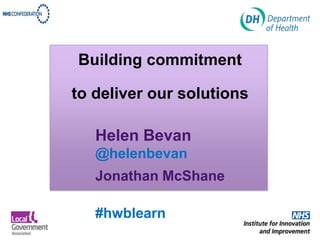
Helen Bevan, 8 Nov presentation
- 1. Building commitment to deliver our solutions Helen Bevan @helenbevan Jonathan McShane #hwblearn
- 3. What is our approach to change? From To Compliance Commitment States a minimum States a collective goal that performance standard that everyone can aspire to everyone must achieve Uses hierarchy, systems and Based on shared standard procedures for co- goals, values and sense of ordination and control purpose for co-ordination and control Threat of penalties/ Commitment to a common sanctions/ shame creates purpose creates energy for momentum for delivery delivery Source: Helen Bevan
- 4. “Money incentives do not create energy for change; the energy comes from connection to meaningful goals” Ann-Charlott Norman, Talking about improvements: discursive patterns and their conditions for learning, March 2012
- 5. burning platform versus burning ambition @PeterFuda
- 6. Lessons for transformational change 1. In order to sustain transformational change, we as leaders need to move from a burning platform (fear based urgency) to a burning ambition (shared purpose for a better future) 2. We as leaders need to articulate personal reasons for change as well as organisational reasons 3. If the fire (the compelling reason) goes out, all other factors are redundant @PeterFuda
- 7. [Shared] purpose goes way deeper than vision and mission; it goes right into your gut and taps some part of your primal self. I believe that if you can bring people with similar primal-purposes together and get them all marching in the same direction, amazing things can be achieved. Seth Garguilo
- 8. Discretionary effort is contractual is personal
- 9. Avoiding “de facto” purpose • What leaders pay attention to matters to staff, and consequently staff pay attention to that too • Shared purpose can easily be displaced by a “de facto” purpose: hitting a target reducing costs reducing length of stay eliminating waste completing activities within a timescale complying with an inspection regime • If purpose isn’t explicit and shared, then it is very easy for something else to become a de facto purpose in the minds of the workforce Source: Delivering Public Services That Work: The Vanguard Method in the Public Sector
- 10. What focus for our improvement projects? 25 20 No of projects 15 10 5 0 1 2 3 4 5 6 7 8 9 Mainly focussed Project Score Mainly focussed on quality, safety on and/or patient cost, productivity experience or efficiency Source: 100 improvement projects on national improvement leadership programme October 2012
- 11. If we want people to take action, we have to connect with their emotions through values values emotion action Source: Marshall Ganz
- 12. Building commitment: what do we need to do? 1. Tell a story
- 13. Building commitment: what do we need to do? 1. Tell a story 2. Make it personal
- 14. Building commitment: what do we need to do? 1. Tell a story 2. Make it personal 3. Be authentic
- 15. Building commitment: what do we need to do? 1. Tell a story 2. Make it personal 3. Be authentic 4. Create a sense of “us” (and be clear about who the “us” is)
- 16. Building commitment: what do we need to do? 1. Tell a story 2. Make it personal 3. Be authentic 4. Create a sense of “us” (and be clear who the “us” is) 5. Build in a call for urgent action
- 17. Task • Find a “partner” to talk to (person A&B) • Person A: tell person B a story about an experience in your life that shaped who you are today (3 minutes) • Person B: do the same to person A (3 minutes)
- 18. Task • What did you learn about each other and your shared values through the stories? • What unites you? Creates a sense of “us” 3 minutes
- 19. Helen’s favourite change management book of 2012 (it should be mandatory reading for Health and Wellbeing Boards) 1. Connections create value 2. Power in community 3. Collaboration > control 4. Celebrate onlyness 5. Allow all talent 6. Consumers become co-creators 7. Mistakes can build trust 8. Learn. Unlearn. (Repeat) 9. Bank on openness 10. Social purpose unleashes ownership 11. (There are no answers)
Notas do Editor
- So Emotions help us understand what we value in the world. Why did the story of Alice work ?So why was this story powerful?Why do we respond differently when we hear about Alice rather than when we see the policy data and financial balance sheet?So public narrative when used intentionally for a purpose to connect with others to move to action is a powerful skills set and leadership gift. When we hear stories that make us feel a certain way those stories remind us of our core values. We experience our values through emotions. Then we are prepared to take action on those values. Through our emotions we are more likely to take action Research by Martha Nussbaum a Moral philosopher, tells us that people who have a damaged (a-mig-da- la) Amygadla the part of the brain which controls emotions, when faced with decisions can come up with many options from which to choose but cannot make a decision because the decision rests upon judgements of value. If we cannot feel emotion we cannot experience values that orient us to the choices we must make Shortly we will be thinking about the lived experiences that have moved you to action…we’ll be drawing on those a few minutes as you start to craft your own stories.